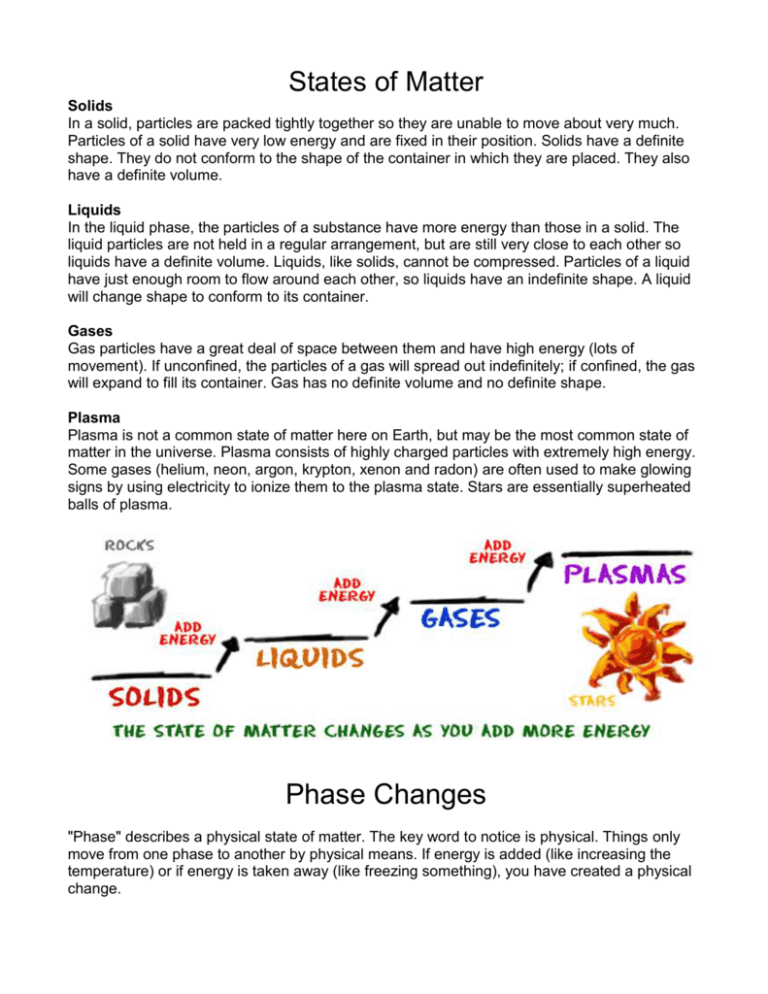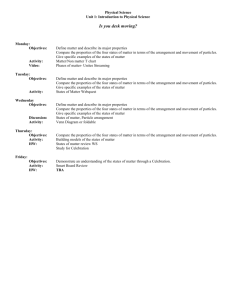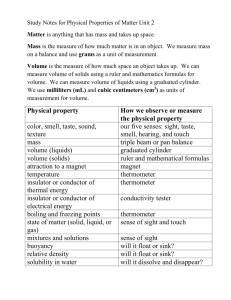States of Matter
advertisement

States of Matter Solids In a solid, particles are packed tightly together so they are unable to move about very much. Particles of a solid have very low energy and are fixed in their position. Solids have a definite shape. They do not conform to the shape of the container in which they are placed. They also have a definite volume. Liquids In the liquid phase, the particles of a substance have more energy than those in a solid. The liquid particles are not held in a regular arrangement, but are still very close to each other so liquids have a definite volume. Liquids, like solids, cannot be compressed. Particles of a liquid have just enough room to flow around each other, so liquids have an indefinite shape. A liquid will change shape to conform to its container. Gases Gas particles have a great deal of space between them and have high energy (lots of movement). If unconfined, the particles of a gas will spread out indefinitely; if confined, the gas will expand to fill its container. Gas has no definite volume and no definite shape. Plasma Plasma is not a common state of matter here on Earth, but may be the most common state of matter in the universe. Plasma consists of highly charged particles with extremely high energy. Some gases (helium, neon, argon, krypton, xenon and radon) are often used to make glowing signs by using electricity to ionize them to the plasma state. Stars are essentially superheated balls of plasma. Phase Changes "Phase" describes a physical state of matter. The key word to notice is physical. Things only move from one phase to another by physical means. If energy is added (like increasing the temperature) or if energy is taken away (like freezing something), you have created a physical change. Melting and freezing When heat is applied to a solid, its particles begin to vibrate faster and tend to move farther apart. When the substance reaches the melting point — the solid will start to turn into a liquid. The freezing point is the temperature at which a liquid substance is cooled enough to form a solid. As the liquid is cooled, particle motion slows. In many substances, the particles align in precise, geometric patterns to form crystalline solids. Sublimation When a solid is converted directly into a gas without going through a liquid phase, the process is known as sublimation. Sublimation occurs when the energy of the particles is greater than the pressure around them. This may occur when the temperature of the sample is rapidly increased beyond the boiling point (flash evaporation). More commonly, a substance can be "freeze dried" by cooling it under vacuum conditions so that the water in the substance undergoes sublimation and is removed from the sample. A few substances will undergo sublimation at normal temperature and pressure. The best known of these substances is CO2 or “dry ice.” Evaporation Evaporation is the conversion of a liquid to a gas. Because the particles of a liquid are in constant motion they frequently collide with each other, transferring energy when they do so. This energy transference has little net effect beneath the surface, but when enough energy is transferred to a particle near the surface; it may gain enough energy to be knocked completely away from the sample as a free gas particle. This process is called evaporation and it continues as long as liquid remains. Condensation and deposition Condensation is when a gas turns into a liquid. Think of the lid of a pot when you place it over boiling water. The evaporated water condenses to form a liquid on the lid. When gas transforms directly into a solid, without going through the liquid phase, it is called deposition. An example of this occurs when subfreezing temperatures convert water vapor in the atmosphere into frost or ice. Frost tends to outline solid blades of grass and twigs because the air touching these solids cools faster than air that is not touching a solid surface.











